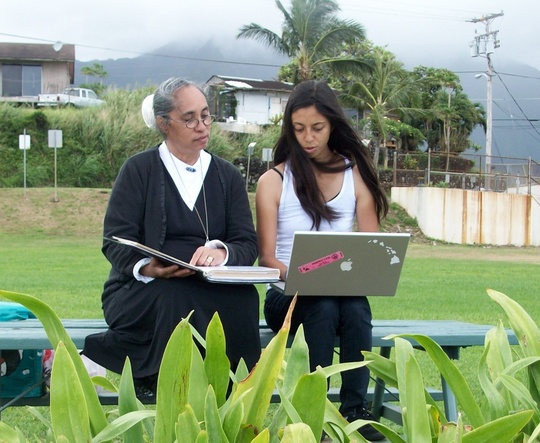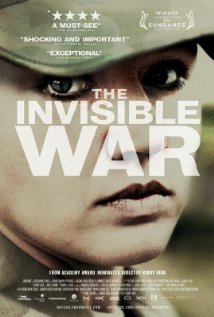
Seven Need-to-Know Basics for Your Documentary's National Public TV Broadcast
by Christen Hepuakoa Marquez
Documentary filmmakers produce work because they believe the stories they tell are important, and they want to reach as many people as possible. Public Television (PTV) is one platform where doc makers hope their work will be shown because it is still one of the most widely trusted and watched outlets for non-fiction work in the United States.
Five years ago, I was one of these filmmakers with a dream, and now in Spring 2014 my personal documentary E Haku Inoa: To Weave A Name will be seen across the country on PTV. Through the process of development, funding, and producing of my project for PTV I have learned a truckload about how to create a film that is universal enough to resonate with a national audience, while still specific enough to give unique insight into Native Hawaiian identity and mental illness (view trailer).
Currently I am in the middle of preparing for my national broadcast debut, which is a process also known as station relations within the PTV system. I will be writing another blog on the steps it takes to prepare your film for broadcast; as soon as it is finished you will be able to check it out here. But I think it is important to first give you some foundational knowledge. Every film is different, but the earlier that you begin to approach your film with the following points in mind, you will be taking steps in the right direction to maximize your project's potential for carriage nationally within the PTV system.
This article is especially helpful for first-time PTV producers, people unfamiliar with the PTV landscape, and producers who have a one-off documentary for a PTV film that is not programmed within a flagship strand such as POV, Independent Lens, American Masters, or Frontline.
What Exactly is Public Television?
This seems basic, but when most people say that they want their documentary on “PBS,” what they really mean is public television. The creation of PTV today is marked by the Public Broadcasting Act of 1967. This act created the Corporation for Public Broadcasting, which is also known as The Corporation or CPB. CPB established public television as it is today in this country and still helps fund public television in the United States.
The Public Broadcasting System (PBS) is a specific non-profit media brand that distributes content to PTV affiliates that pay a subscription to be members of the PBS service. PBS is a major distributor of content to the public television system, but they are not the only game in town. Here is a simple breakdown of basic differences between CPB, PBS, and National Public Radio (NPR):
Understand the Public TV Distribution System
Public television is not like any other television network. Each station has the flexibility to program independently of each other. The idea behind this is that it allows each station to serve its audience with programming that is most relevant to its local community. In fact, it is not actually a network. It is what is referred to as an affiliation of stations. Since the public television system is not a network, but an affiliation of stations, that means there is not a homogeneous programming schedule nationally.
If your film is lucky enough to be programmed on one of the PBS strands that I mentioned before, like Independent Lens, POV, or American Experience, these strands often come with their own promotions and station relations teams, which means there is little responsibility on the individual filmmaker.
If your film is being offered as a one-off, you will need to make sure that station programmers are aware that your film is going to be offered via your distribution service in order to make sure that your project is actually picked up and broadcast to the public. There are 188 markets - many with several stations in each market - in the PTV system and it is a big task to take on, so that is why it is important to create a solid plan of attack. You will usually want to focus on the top 50 public television markets and any others that have a specific connection to your film.
Know How Your Film Fulfills Public Television's Objectives
The three D's of public television are digital, diversity, and dialogue. Most program producers for the broadcast market will be focusing on diversity and dialogue, but if you have ideas on how to incorporate a digital aspect into the outreach for your project, all the better.
If you are producing your film with PTV in mind you should also be aware of the “Explorer Archetype” and how it relates to the PBS brand. It will be helpful to you in terms of thinking and talking about why your film is relevant to a general audience.
Create Partnerships Early On with Influencers in the Public TV System
The earlier in development and production that you can get individuals and organizations within public television behind your film, the greater leverage you will have when it comes time for broadcast. Many people are lured to funding initiatives offered by the Independent Television Service (ITVS) and the National Minority Consortia (NMC), but often what is more valuable is the stamp of approval for PTV that your project receives when supported by these organizations. It is important to understand that when your project is funded by one of these organizations it is not a grant. It is a contract that is securing the domestic television rights for your project for PTV. If they have supported your project financially and your film has met PTV requirements, these organizations will have an interest in helping your film reach the largest possible audience.
As I mentioned earlier PBS is the largest distributor of content to the PTV system, but there are two other main distributors for public television programming. They are American Public Television (APT) and National Educational Telecommunication Association (NETA). My film is being offered to the PTV system through NETA.
I will caution that the process of applying to and receiving PTV funding takes time and patience, but if you approach the relationship as an opportunity to engage in a mutually beneficial partnership, it will allow your project to grow and provide your PTV supporters with content they are proud to be a part of. It is certainly worth the effort if you are intent on PTV as the broadcast outlet for your film in the United States.
Make Great Promotional Materials
Having beautiful promotional materials is important for any kind of film. Narrative or documentary. Theatrical or public television. If you have a eye-catching poster or postcard that communicates in one image what your film is about, it will make your film more appealing to programmers. You should also have a one-liner description of your film, a one paragraph synopsis, and ten still photographs with captions on hand to promote your film. A press release and trailer are also incredibly helpful to have as well.
Here are a few examples of posters for public television documentaries:




Give Programmers the Tie-ins They Need
E Haku Inoa: To Weave A Name follows my personal journey as I reconnect with my mother who was diagnosed with schizophrenia when I was a young girl. Over the course of the story, Native Hawaiian culture plays a huge role in how my mother and I relate to each other. The main categories that my film hits upon are Pacific Islander heritage, mental health, and female relationships.
PTV programmers want to get as many people watching their channel as possible, and one of the ways they look to get more eyeballs on their content is to leverage existing events, anniversaries, and celebrations. It just so happens that Pacific Islander Heritage Month, Mental Health Awareness Month, and Mother's Day all fall in the month of May. Are you serious? Three tie-ins, heck yeah! Having those kinds of hooks make your film appealing to programmers especially because it helps them organize their schedule around a cohesive theme. I have been surprised at how popular Mother's Day has been as a broadcast date for my film, the strategy is working!
Think of how your film could fit into a day that has an established mission for awareness on a specific topic. Earth Day, MLK Day, or National Gay Mens Health Day could be possibilities for your film. Be creative and keep the CPB mission and audience in mind.
Be Strategic About Timing Your Station Relations Campaign
Since the month of May was the month that made the most sense for my film in terms of attractive tie-ins for programmers, that became the broadcast offering window that we targeted for our feed. After figuring out our ideal broadcast window we could reverse engineer when we should start our station relations campaign. Four to five months is a typical amount of time to allow for a robust outreach plan to station programmers across the country. That may seem like an excessive amount of time, but trust me, there's a lot to do.
It is an intense process to program your film nationally, and I have had plenty of help. If you have a great film, that fits the public media landscape, and you and your station relations team are able to expertly discuss your film within the framework that I have outlined, you will be well on your way.
If you are getting ready promote your film for a national broadcast, my next article will outline the specific materials, steps, and milestones that you need to anticipate when working on your public television station relations plan.
Christen Hepuakoa Marquez is a Hawaiian independent producer and filmmaker living in Los Angeles. Her company website is www.paradocsproductions.com, and her portfolio can be seen at www.christenm.com.
Categories: Broadcast